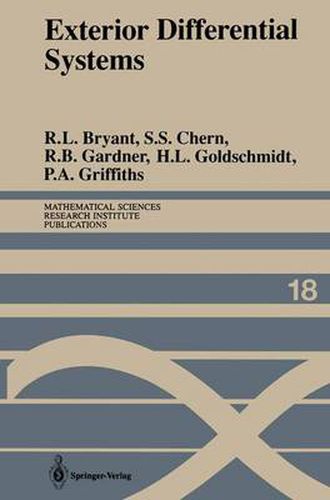Readings Newsletter
Become a Readings Member to make your shopping experience even easier.
Sign in or sign up for free!
You’re not far away from qualifying for FREE standard shipping within Australia
You’ve qualified for FREE standard shipping within Australia
The cart is loading…






This title is printed to order. This book may have been self-published. If so, we cannot guarantee the quality of the content. In the main most books will have gone through the editing process however some may not. We therefore suggest that you be aware of this before ordering this book. If in doubt check either the author or publisher’s details as we are unable to accept any returns unless they are faulty. Please contact us if you have any questions.
This book gives a treatment of exterior differential systems. It will in clude both the general theory and various applications. An exterior differential system is a system of equations on a manifold defined by equating to zero a number of exterior differential forms. When all the forms are linear, it is called a pfaffian system. Our object is to study its integral manifolds, i. e. , submanifolds satisfying all the equations of the system. A fundamental fact is that every equation implies the one obtained by exterior differentiation, so that the complete set of equations associated to an exterior differential system constitutes a differential ideal in the algebra of all smooth forms. Thus the theory is coordinate-free and computations typically have an algebraic character; however, even when coordinates are used in intermediate steps, the use of exterior algebra helps to efficiently guide the computations, and as a consequence the treatment adapts well to geometrical and physical problems. A system of partial differential equations, with any number of inde pendent and dependent variables and involving partial derivatives of any order, can be written as an exterior differential system. In this case we are interested in integral manifolds on which certain coordinates remain independent. The corresponding notion in exterior differential systems is the independence condition: certain pfaffian forms remain linearly indepen dent. Partial differential equations and exterior differential systems with an independence condition are essentially the same object.
$9.00 standard shipping within Australia
FREE standard shipping within Australia for orders over $100.00
Express & International shipping calculated at checkout
This title is printed to order. This book may have been self-published. If so, we cannot guarantee the quality of the content. In the main most books will have gone through the editing process however some may not. We therefore suggest that you be aware of this before ordering this book. If in doubt check either the author or publisher’s details as we are unable to accept any returns unless they are faulty. Please contact us if you have any questions.
This book gives a treatment of exterior differential systems. It will in clude both the general theory and various applications. An exterior differential system is a system of equations on a manifold defined by equating to zero a number of exterior differential forms. When all the forms are linear, it is called a pfaffian system. Our object is to study its integral manifolds, i. e. , submanifolds satisfying all the equations of the system. A fundamental fact is that every equation implies the one obtained by exterior differentiation, so that the complete set of equations associated to an exterior differential system constitutes a differential ideal in the algebra of all smooth forms. Thus the theory is coordinate-free and computations typically have an algebraic character; however, even when coordinates are used in intermediate steps, the use of exterior algebra helps to efficiently guide the computations, and as a consequence the treatment adapts well to geometrical and physical problems. A system of partial differential equations, with any number of inde pendent and dependent variables and involving partial derivatives of any order, can be written as an exterior differential system. In this case we are interested in integral manifolds on which certain coordinates remain independent. The corresponding notion in exterior differential systems is the independence condition: certain pfaffian forms remain linearly indepen dent. Partial differential equations and exterior differential systems with an independence condition are essentially the same object.